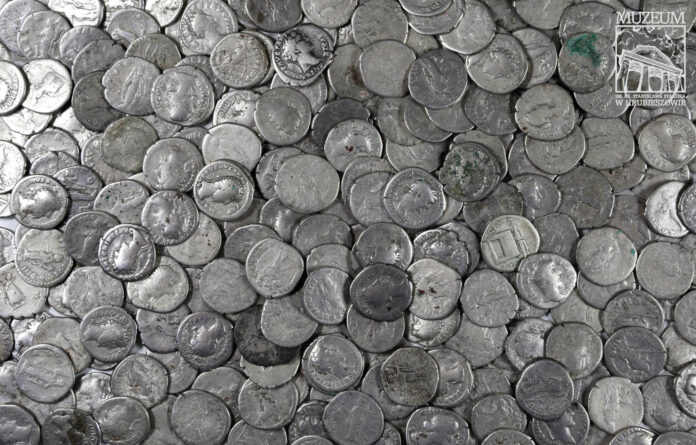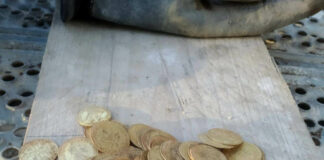
In 2019, Mariusz Dyl looked for antlers on his field and found silver coins, as various online media reported this year. Dyl’s field is located near Cichoborz, south of the town of Hrubieszow (Lublin Province) in eastern Poland near the border with Ukraine.
5.5 Kilograms Worth of Roman Silver Coins
As is often the case, the coins were brought to the surface and spread over a large area as the result of being churned up by agricultural equipment. Mariusz Dyl immediately informed the local museum in Hrubieszow. Archaeologists and volunteers found further 137 coins, resulting in a total of 1,753 denarii that probably had been buried in a leather bag or wooden chest.
Bartłomiej Bartecki, the director of the Hrubieszow museum, confirmed that the treasure of about 5.5 kg of coins is now at the local museum and is planned to be stored there permanently. Currently, Bartecki is trying to raise the funds for a comprehensive analysis of the coins and a publication, both planned for 2021/2022. An exhibition (maybe online) is also being considered for as soon as 2021.
1,753 Denarii: the “Crown of Polish Archaeology”
Polish archaeologists are thrilled about the treasure find. The Nauka w Polsce website quotes Bartecki: “This is undoubtedly the largest treasure from the Roman period in the Lublin region and one of the largest found so far in Poland.” Andrzej Kokowski from the Archaeology Institute of the Maria Curie-Sklodowska University in Lublin stated in the Archaeology New Network: “The treasure will be the crown of Polish archaeology.”
The hoard of coins consists of denarii, the earliest pieces were minted under Vespasianus (69-79) and the latest under the rule of Septimius Severus (193-211) as Bartecki corrected previous media reports based on the current state of analysing. Bartecki compared the amount to the pay for Roman legionaries, who earned about 300 denarii a year, thus, the treasure was worth six times the annual salary of a soldier: “You couldn’t buy a village for this, but it was not a small amount, especially for barbarian tribes.”
No Silver Coins, No Future
In the 2nd century, the Germanic tribe of the Vandals lived in this region, however, they were pushed to the west by the invading Goths. These migratory movements started to put heavy pressure on the Roman Empire in the 3rd century. According to Polish archaeologists, the Vandals hid treasures like this one before they fled in the hope of returning soon. However, it turned out that this decision had dramatic consequences because, as Kokowski explained to the Archaeology New Network: the Goths stayed and the Vandals couldn’t return. And without their valuables, they no longer had the financial means to recruit mercenaries. “That is why the Goths peacefully spread to the whole south-east and occupied (present-day) Ukraine.” The Vandals had no option but to flee to unknown territories, they moved on and founded a new empire in North Africa. On the way they plundered the Eternal City of Rome in 455 – and established the term “vandalism”.
This is the website with the first statement of the local museum in Hrubieszow.
And this is the article by the Archaeology News Network.
Another article was published by Nauka w Polsce.








